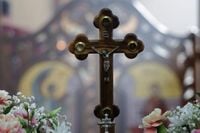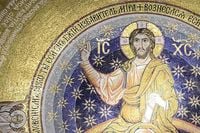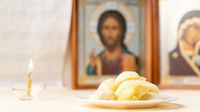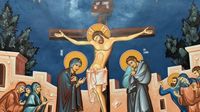Today, April 18, 2025, marks Great Friday, a significant day in the Christian calendar, particularly for Orthodox believers. This day, also known as the saddest day of Christianity, symbolizes the suffering and crucifixion of Jesus Christ on Golgotha. It is a day steeped in tradition, reflection, and solemnity, where the faithful engage in strict fasting and observe various customs that honor the sacrifice of Christ.
Great Friday is remembered for the key events leading up to Christ’s crucifixion, beginning with His trial before Pontius Pilate and culminating in His crucifixion. According to Christian tradition, this day is filled with sorrow as believers recall the moment when Jesus accepted His fate, taking upon Himself the sins of humanity. It is a day when church bells remain silent, symbolizing the absence of joy, and congregants are called to worship through wooden clappers instead.
In Orthodox churches, the holy liturgy is not served on Great Friday, with the exception of instances when the Annunciation coincides with this day. Instead, the focus is on the unveiling of the shroud, known as the plaštanica, which depicts the burial of Christ. This shroud is displayed on a specially adorned table that represents Christ's tomb, allowing the faithful to kiss it in a gesture of respect and mourning. This tradition of honoring the shroud has deep roots, reflecting the profound sorrow of the day.
As part of the observance, believers are encouraged to engage in prayer and contemplation. Many spend the day in silence, reflecting on the significance of Christ's suffering. The customs associated with Great Friday include strict fasting, where adherents consume only dry bread and water, along with boiled vegetables, fresh or dried fruits, honey, and boiled rice. This fasting is seen as a sign of respect for Christ’s sacrifice and is integral to the day’s observance.
In many households, the tradition of dyeing Easter eggs is also observed on Great Friday. The first eggs are typically dyed red, symbolizing the blood of Christ, and one egg, known as the 'cuvarkuca', is kept until the next Easter as a protective charm. Women often add blessed water to the dyeing process, ensuring that their efforts are accompanied by prayer and reverence. Before beginning this task, it is customary for them to cross themselves and offer a prayer, setting a spiritual tone for the preparations ahead.
According to folk beliefs, the weather on Great Friday holds significant meaning. Rain on this day is said to predict a poor harvest, particularly for plums and other fruits, while a sunny and warm day is believed to herald a bountiful year. These beliefs reflect the deep connection between faith and the natural world, illustrating how traditions have evolved to intertwine with agricultural practices.
In addition to fasting and egg dyeing, there are several prohibitions that are traditionally observed on Great Friday. It is considered improper to engage in any form of merriment or to perform heavy physical labor. Many believers refrain from singing or celebrating, focusing instead on the solemnity of the day. Certain customs dictate that sharp objects, such as needles and nails, should not be handled, as it is believed that doing so could metaphorically 'injure Jesus' wounds'. This belief leads to the cessation of work among shoemakers and tailors on this day.
Great Friday is also a time for spiritual introspection and community connection. Many congregants attend church services to participate in the evening ritual of the shroud unveiling. This event is marked by a profound sense of unity among the faithful, who gather to honor the memory of Christ's sacrifice. In some regions, it is customary for believers to crawl under the table where the shroud is laid, making a wish as they do so, a practice that underscores the day’s themes of hope and faith.
The history of egg dyeing can be traced back to the 12th century, with the practice becoming more formalized in the 16th century. Historical accounts indicate that decorated eggs were even presented to local authorities as a form of tribute during the Easter season. This rich tradition has persisted through the centuries, evolving into a cherished custom that many families look forward to each year.
As Great Friday unfolds, the atmosphere is one of reflection and reverence. The absence of bells, the solemnity of the services, and the practices of fasting and egg dyeing all contribute to a day that is deeply meaningful for Orthodox Christians. It serves as a poignant reminder of the sacrifices made by Christ and the hope that His resurrection brings.
In summary, Great Friday is not just a day of sorrow but also a day of preparation for the joyous celebration of Easter that follows. The observance of customs and traditions allows believers to connect with their faith, reflect on the deeper meanings of sacrifice and redemption, and prepare their hearts for the celebration of Christ’s resurrection. As families gather to dye eggs and share in the spirit of the day, they reinforce the bonds of community and faith that are central to their beliefs.









